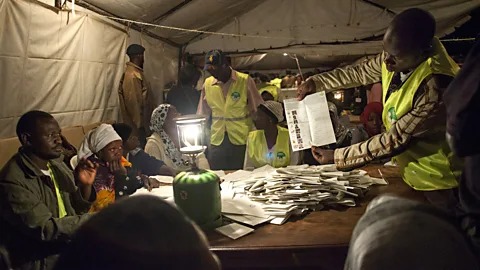
Kenya Intimidation is the phrase capturing Amnesty International’s recent findings about state-led tech-enabled harassment of young protesters. The report documents how authorities used paid social media networks, surveillance tools, AI content and disinformation campaigns against Gen Z-led demonstrations between 2024 and 2025. The revelations raise major questions about digital rights, free expression and accountability in Kenya. Amnesty’s team compiled interviews, technical analysis and documentary evidence to map a coordinated effort that combined online harassment with offline intimidation — a pattern that human rights groups say amounts to tech-facilitated violence. These findings have prompted international attention and domestic denials, but they mark a turning point in how political dissent can be suppressed online.
Kenya Intimidation describes how authorities allegedly funded or coordinated networks of paid trolls to attack, doxx and threaten protest leaders. Amnesty’s report documents instances where hundreds of coordinated accounts pushed the same narratives, amplified abusive messaging, and shared private data to discredit activists. The trolls often spread allegations that protest organisers were foreign-backed or morally suspect, tapping into social divisions to reduce public sympathy for protests. The coordinated nature of these networks — repeated messaging, similar posting times and re-used content — is central to Amnesty’s conclusion about deliberate state involvement. Such tactics aimed not only to silence individuals but to reshape public sentiment online
Kenya Intimidation also included digital surveillance methods that tracked activists’ phones, social media and locations. Amnesty found evidence of suspicious device logins, leaks of private messages, and targeted threats that suggested access to personal data. Activists reported unusual tracking, threatening messages that quoted private conversations, and attempts to identify protest organisers’ networks. When surveillance is combined with offline police actions — arrests or sudden raids — the chilling effect on mobilization is dramatic. The report warns that surveillance technology, when deployed without oversight, becomes a tool for political repression rather than security.
Kenya Intimidation involved not only human-run troll farms but also large disinformation campaigns, including AI-generated videos and false narratives designed to smear activists. Amnesty documented episodes where fabricated clips and misleading posts were widely circulated to link protests to criminal activity or foreign influence. The use of synthetic media on platforms like TikTok and X expanded the speed and reach of these narratives. Disinformation campaigns aim to confuse audiences, reduce trust in genuine reporting, and create plausible pretexts for harsher state responses. Digital literacy and platform accountability are key defenses against such tactics
Kenya Intimidation was not restricted to screens. The report and subsequent coverage show an overlap between online harassment and real-world intimidation, including hired mobs and plainclothes officers confronting demonstrators. Journalists and human rights groups documented incidents where online campaigns preceded street attacks or targeted arrests. This blending of online and offline tactics magnifies harm: online smears isolate activists socially, while street violence physically suppresses dissent. The twin strategy makes it harder for civil society to organise safely and forces many young activists to self-censor or flee.
Kenya Intimidation also refers to the use of laws and courts to deter dissent. Amnesty’s research highlights how cybercrime laws and broad national security provisions were applied to protesters, sometimes after online campaigns had already soaked public perception with falsehoods. Charging protesters under terrorism or cybercrime statutes magnifies fear, gives cover to harsh policing, and creates legal risks for organisers. Rights groups warn that criminalisation becomes an additional layer of intimidation when paired with coordinated online harassment.
Kenya Intimidation has a chilling effect on the very demographic that powered the protests: young people. The report records activists dropping out of public roles after coordinated doxxing, threats to families, or targeted smear campaigns. When activists see peers arrested or threatened online and offline, recruitment and participation fall. Civil society organisations face extra obstacles when their staff or volunteers are targeted. The long-term impact may be weaker civic engagement at a time when public debate is crucial for democratic accountability.
Kenya Intimidation must be addressed by remedies that include independent investigations, platform transparency, and legal safeguards for digital rights. Amnesty calls for impartial probes into the alleged coordinated campaigns, restrictions on abusive surveillance, safeguards for protest rights, and stronger oversight on the use of cybersurveillance. Platforms must act faster to identify coordinated state-linked manipulation. Lastly, democratic safeguards — clearer legal limits and access to justice — are necessary to deter future abuses and restore trust in civic space
Q1: What is Kenya Intimidation?
Kenya Intimidation refers to alleged state-linked digital and offline tactics to harass and silence Gen Z protesters.
Q2: Who reported these tactics?
Amnesty International documented and reported these tactics in a November 2025 report.
Q3: What should authorities do now?
Authorities should launch independent probes, suspend abusive surveillance, and guarantee protest rights while platforms increase transparency.
Kenya Intimidation captures a worrying pattern in which digital tools, paid trolls, surveillance and legal pressure combined to suppress youth protests in 2024–2025. Amnesty’s findings demand urgent action: independent investigations, stronger digital rights, and platform accountability. Without credible remedies, the chilling pattern of tech-enabled repression could spread and further erode democratic freedoms in Kenya and beyond.